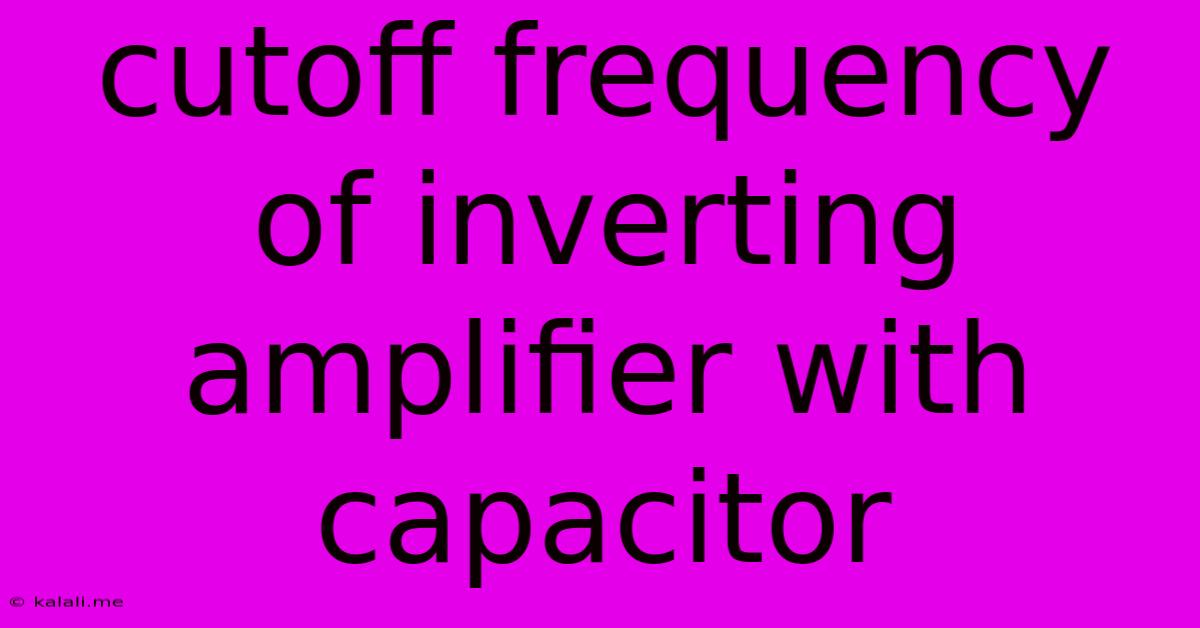Cutoff Frequency Of Inverting Amplifier With Capacitor
Kalali
May 22, 2025 · 3 min read

Table of Contents
Understanding the Cutoff Frequency of an Inverting Amplifier with a Capacitor
The humble inverting amplifier, a cornerstone of analog circuit design, can exhibit interesting frequency-dependent behavior when a capacitor is introduced into the feedback loop or input path. This article delves into understanding how a capacitor affects the amplifier's response, specifically focusing on determining its cutoff frequency. We'll explore the underlying principles and provide a clear explanation of the calculations involved.
The Role of Capacitance in Inverting Amplifiers
An ideal operational amplifier (op-amp) has infinite bandwidth. However, real-world op-amps have limitations. Adding a capacitor to an inverting amplifier circuit introduces a frequency-dependent impedance, altering the gain and creating a cutoff frequency (also known as the -3dB frequency or corner frequency). This cutoff frequency marks the point where the amplifier's gain drops by 3dB (approximately 30%) from its maximum gain in the passband. Beyond this point, the amplifier enters its roll-off region, exhibiting progressively lower gain with increasing frequency. This is crucial for understanding signal integrity and designing stable systems.
Determining the Cutoff Frequency: Feedback Capacitor
Let's consider the common scenario where a capacitor, denoted as C<sub>f</sub>, is placed in parallel with the feedback resistor R<sub>f</sub> in an inverting amplifier configuration. This arrangement creates a low-pass filter. The cutoff frequency (f<sub>c</sub>) can be calculated using the following formula:
f<sub>c</sub> = 1 / (2πR<sub>f</sub>C<sub>f</sub>)
where:
- f<sub>c</sub> is the cutoff frequency in Hertz (Hz).
- R<sub>f</sub> is the feedback resistor in Ohms (Ω).
- C<sub>f</sub> is the feedback capacitor in Farads (F).
This formula highlights the inverse relationship between the cutoff frequency and the product of the feedback resistor and capacitor. Increasing either R<sub>f</sub> or C<sub>f</sub> will lower the cutoff frequency, resulting in a lower bandwidth. Conversely, decreasing either will increase the cutoff frequency, widening the bandwidth.
Determining the Cutoff Frequency: Input Capacitor
Adding a capacitor, C<sub>i</sub>, in series with the input resistor, R<sub>i</sub>, creates a high-pass filter. This configuration allows higher-frequency signals to pass through while attenuating lower-frequency signals. The cutoff frequency in this case is calculated using a similar formula:
f<sub>c</sub> = 1 / (2πR<sub>i</sub>C<sub>i</sub>)
where:
- f<sub>c</sub> is the cutoff frequency in Hertz (Hz).
- R<sub>i</sub> is the input resistor in Ohms (Ω).
- C<sub>i</sub> is the input capacitor in Farads (F).
This again shows the inverse relationship. A larger R<sub>i</sub> or C<sub>i</sub> reduces the cutoff frequency, while smaller values increase it.
Practical Considerations and Implications
The presence of these capacitors significantly influences the amplifier's frequency response. Understanding the cutoff frequency is vital for several reasons:
-
Signal Filtering: Carefully selecting the capacitor values allows for intentional filtering of unwanted frequencies. This is crucial in applications requiring specific frequency ranges, such as audio amplifiers or signal processing circuits.
-
Stability: In high-frequency applications, the parasitic capacitances of the components themselves can introduce unforeseen effects. Understanding the cutoff frequency helps in designing stable amplifier circuits.
-
Gain Control: The gain of the amplifier is frequency-dependent beyond the cutoff frequency. This needs to be considered when designing circuits with precise gain requirements.
-
Compensation Techniques: Advanced techniques like Miller compensation utilize capacitors to improve the stability and bandwidth of operational amplifiers.
Conclusion
The cutoff frequency of an inverting amplifier with a capacitor is a critical parameter to understand for any circuit designer. By carefully considering the values of the resistors and capacitors, you can precisely control the amplifier's frequency response and ensure its proper operation within the intended application. Accurate calculation of the cutoff frequency using the formulas provided is essential for achieving desired performance and avoiding unexpected behavior. Remember to account for both input and feedback capacitors if present in your circuit.
Latest Posts
Latest Posts
-
Latex Equation Allinment Ot The Right
May 23, 2025
-
Civicrm 0 Cannot Access Offset Of Type String On String
May 23, 2025
-
An Increasing Function With Zero Derivative Almost Evertwhere
May 23, 2025
-
Android Messenger Spell Check Not Working
May 23, 2025
-
One Second Delay In System Traffic
May 23, 2025
Related Post
Thank you for visiting our website which covers about Cutoff Frequency Of Inverting Amplifier With Capacitor . We hope the information provided has been useful to you. Feel free to contact us if you have any questions or need further assistance. See you next time and don't miss to bookmark.